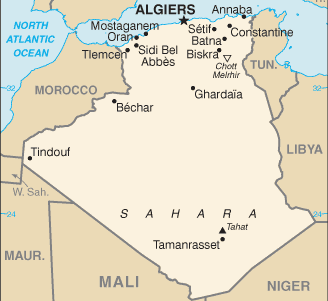Africa > Algeria: Weather, Map, Costs and Travel Guide

Algeria : When and where to go?
Click on a city for complete climate and weather tables
| Town | Jan | Feb | Mar | Apr | May | June | July | Aug | Sept | Oct | Nov | Dec |
| Algiers |  |  |  |  |  |  |  |  |  |  |  |  |
Algeria: Climate & Weather
The northern part of the country has a Mediterranean type climate with hot dry summers and mild, humid winters. The Saharan area has a desert climate with large differences of temperature between day and night (45°C during the daytime and 5°C at night) with areas where rain does not fall for years on end, sometimes even for decades.
Visiting the Sahara is obviously better during winter, if possible before April when the heat starts to be overbearing. The Algerian coastline is great to explore at any time due to the mild temperatures during winter and supportable temperatures in summer.
Weather today

Heavy Rain
Wind: 5 km/h
Precipitation forecast: 16,7 mm
> Full report and 7-days forecast
Data updated at 16:16 (local time)
At that time, the weather was:
 15 °C / Rain
15 °C / Rain
Algeria: Map

Sponsored links
What to do in Algeria
Algeria still has many undiscovered marvels; the mosques, Our Lady of Africa Basilica, the Rais Palace and the Bardo Museum to name but a few. Oran is not to be outdone either with its Sacred Heart Cathedral, the old town of Ghardaïa, the cemetery and the subterranean mosque together with its rugs. Tlemcen will seduce you with its medina and its mosques.
The Sahara is the jewel in the crown of Algeria and it would be a shame to miss the chance of discovering it. In the Tamanrasset area, with its streets of sand and its cubic houses, the Hoggar and its ochre rocks, its sand dunes and the blue men of the dessert, you will feel as if you have been displaced in time to another world. The Tassili N’Ajjer plain will reveal to you tormented landscapes of canyons and gorges but also its ancient prehistoric rock paintings that date back 4,000 years.
Towards the west, the Timimoun Oasis with its incredible forest of palm trees and ancient salt lakes is also the departure point for forays into the dunes of the Western Grand Erg.
Algeria: The basics
A visa is obligatory.
The currency in circulation is the Algerian Dinar.
Your planned budget will not need to be excessively high: You can eat well, even really well at times, for €10 and a room can be found for €60.
The hotel infrastructure is fairly limited although the good quality hotels are generally less expensive than those of Western Europe.
Concerning health, avoid drinking tap water, peel all fruit and protect yourself from mosquitoes. If you go into the desert take a first aid kit with you and do not forget your sun cream.
For travelling within the country, airplanes and buses function fairly efficiently.
At present it is recommended that you visit Algeria as part of an organised tour group.
The best souvenirs to bring back include traditional silver jewellery, brass and leather objects, pottery and rugs.



